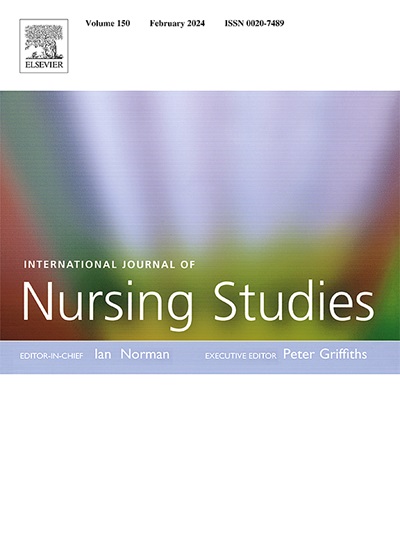Why vital signs observations are delayed and interrupted on acute hospital wards: A multisite observational study
IF 7.5
1区 医学
Q1 NURSING
引用次数: 0
Abstract
Background
Vital signs monitoring is key to identifying deteriorating hospital patients. However, adherence to monitoring protocols is limited, with observations frequently missed or delayed. Previous studies of interruptions and delays to vital signs observations have been descriptive, with none attempting to conceptualise the types of tasks that are prioritised over vital signs observations.
Objective
This paper aims to explore how nursing teams perform vital sign observations on acute hospital wards and conceptualises which types of work delay or interrupt them.
Design
Non-participant observational study.
Setting(s)
Four hospitals in the south of England.
Methods
Eligible adult wards (surgical and medical) within each hospital were randomly sampled for inclusion. Four sets of two-hour daytime observation sessions were undertaken on each ward. Two observers recorded structured and unstructured observations (open comments, field notes) on a tablet with adapted QI Tool software. We collected data over 128 h, including 715 sets of vital signs observations and 1127 interruptions. We undertook a qualitative content analysis of interruptions and delays to planned vital signs observations using both structured and unstructured observations.
Results
We identified eight reasons why vital signs were delayed or interrupted: fixed routines, staff availability, bundled care, proximity-related activities, collaborative care, patient inaccessible or unavailable, requests for or responses to time-critical activities, or limited context available. We propose a new concept of ‘temporal status.’ Flexible care (vital signs observations, ‘bundled care’ and ‘proximity-related care’) has a low temporal status so is delayed in favour of higher temporal status activities (fixed routines and time-critical care).
Conclusions
Our findings could explain why vital signs taken early in the morning and evening are least likely to be postponed, as there may be fewer competing tasks with a higher temporal status at these times. Our work also challenges binary conceptualisations of interruptions as ‘beneficial’ or ‘detrimental’, recognising the complexity of nursing care decisions on a moment-by-moment basis. Our new framework suggests the lower temporal status of vital signs observations (and other flexible care) means they are delayed by higher temporal status tasks during daytime shifts in acute hospitals, regardless of their clinical priority.
Registration
10863045, ISRCTN (6/8/2019).
为什么生命体征观察在急症病房被延迟和中断:一项多地点观察研究
生命体征监测是识别病情恶化患者的关键。然而,对监测方案的遵守是有限的,观察经常被遗漏或延迟。先前对生命体征观察的中断和延迟的研究都是描述性的,没有人试图概念化优先于生命体征观察的任务类型。目的探讨护理团队如何在急症病房进行生命体征观察,并对哪些类型的工作延误或中断进行概念化。设计:非参与者观察性研究。研究环境:英格兰南部的四家医院。方法随机抽取各医院符合条件的成人病房(外科和内科)进行纳入。在每个病房进行四组两小时的日间观察。两名观察员在平板电脑上使用QI工具软件记录结构化和非结构化观察(公开评论,现场笔记)。我们收集了128小时的数据,包括715组生命体征观察和1127次中断。我们使用结构化和非结构化观察对计划生命体征观察的中断和延迟进行了定性内容分析。结果我们确定了生命体征延迟或中断的八个原因:固定的常规、工作人员的可用性、捆绑护理、与附近相关的活动、协作护理、患者无法访问或无法访问、对时间关键活动的请求或响应、或有限的可用环境。我们提出了一个“时间地位”的新概念。灵活护理(生命体征观察、“捆绑护理”和“就近护理”)具有较低的时间地位,因此被推迟,有利于更高时间地位的活动(固定惯例和时间关键型护理)。结论我们的研究结果可以解释为什么在清晨和傍晚测量生命体征最不可能被推迟,因为这两个时间点可能有较少的竞争任务和较高的时间地位。我们的工作也挑战了中断为“有益”或“有害”的二元概念,认识到护理决策的复杂性。我们的新框架表明,生命体征观察(和其他灵活护理)的较低时间状态意味着,无论其临床优先级如何,在急症医院日间轮班期间,它们都被较高时间状态的任务所延迟。注册号10863045,ISRCTN(6/8/2019)。
本文章由计算机程序翻译,如有差异,请以英文原文为准。
求助全文
约1分钟内获得全文
求助全文
来源期刊
CiteScore
15.00
自引率
2.50%
发文量
181
审稿时长
21 days
期刊介绍:
The International Journal of Nursing Studies (IJNS) is a highly respected journal that has been publishing original peer-reviewed articles since 1963. It provides a forum for original research and scholarship about health care delivery, organisation, management, workforce, policy, and research methods relevant to nursing, midwifery, and other health related professions. The journal aims to support evidence informed policy and practice by publishing research, systematic and other scholarly reviews, critical discussion, and commentary of the highest standard. The IJNS is indexed in major databases including PubMed, Medline, Thomson Reuters - Science Citation Index, Scopus, Thomson Reuters - Social Science Citation Index, CINAHL, and the BNI (British Nursing Index).

 求助内容:
求助内容: 应助结果提醒方式:
应助结果提醒方式:


